Retail Furniture Stories -Part 5
by Janet Holt-Johnstone
Teddy Roosevelt once said, “The man who really counts in this world is the doer.” Perhaps he was inspired by the five Stickley brothers, Gustav, Leopold, Albert, John George and Charles. All pioneers of the Arts and Crafts Movement and the conservation ethic, visionary Gustav also ventured into publishing when he founded the periodical, “The Craftsman”, in November, 1902. He and allies like Theodore Roosevelt helped usher in new practices that transformed the use of natural resources in the United States.
Stickley
In the late 1800s, when the first Stickley workshops were advocating the creation of the furniture style “that would integrate furnishings, architecture, handicrafts and the principles of harmonious living”, the concept, that well designed furnishings could help “make life better and truer by its perfect simplicity”, began to gain recognition.
Aminy Audi, now Stickley’s President and CEO, and wife and partner of Alfred Audi for 43 years until his death a little more than three years ago, told us the story.
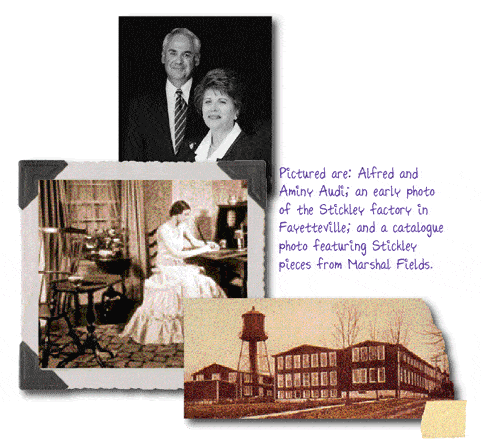
“Leopold Stickley and his younger brother, John George Stickley, began manufacturing furniture in Fayetteville, New York. Alfred’s father, E. J. Audi, eventually became L. and J. G. Stickley’s largest distributor. He admired what Stickley furniture represented in quality construction, finish and enduring value.
“That passion was shared with all Stickley dealers annually at Leopold’s birthday parties in Fayetteville, New York. Alfred, who grew up sleeping in a Stickley bed, accompanied his father to one of these birthdays. He witnessed the incomparable construction of Stickley; and, more importantly, the respect and admiration his father had for Leopold Stickley and his contributions to the American home furnishings scene.
“After graduating from Colgate University in 1960, Alfred joined his family’s furniture business in New York City. He witnessed the loyalty of Stickley customers as they sought to furnish their homes beautifully and provide a haven for their families. So, naturally, when Mrs. Stickley called in 1974 and said, ‘Alfred, you are the only one who loves Stickley enough to keep its quality, would you buy it?’ the response was almost immediate. Thus began our journey, blending the manufacturing and retailing of Stickley products.”
She continued, “The most defining moment was reissuing Mission oak in April of 1989, and following it with Mission cherry in 1991. While Mission, or Arts and Crafts, is very popular today, it was a huge leap of faith on our part, and one that gave us a competitive edge.
“Every chapter in the history of our company is both interesting and challenging. Our consistent growth is partly due to purchasing five other manufacturing companies which enabled us to diversify our product offering. These include: John Widdicomb, Madison Square, Nichols and Stone, Cibola Leather and Heirloom Upholstery.”
We asked Mrs. Audi, “What one issue, cause or policy stands out among all others that ensures the success of your business, benefits your customers and your community?”
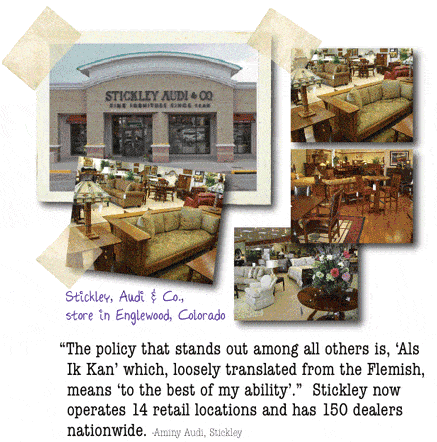
Her answer, “Remaining true to our credo, ‘Als Ik Kan” which, loosely translated from the Flemish, means ‘to the best of my ability’. This applies to manufacturing a quality product, creating value, exceeding our customer’s expectations, selecting and nurturing the finest dealer network, and providing a safe and secure work environment for our employees.”
In 1963, Alfred had met and married Aminy Inati in Beirut, Lebanon. When he purchased Stickley in 1974, the company employed 22 people and operated out of a small out-dated factory. Alfred and Aminy nurtured the company back to health, working on Stickley's infrastructure at the facility in Fayetteville, now home of the Stickley Museum. In 1985, they built a new state-of-the-art home for Stickley in Manilius, New York. After several expansions, it now exceeds 450,000 square feet.
Today, Stickley employs over 1,600 dedicated employees whom Mrs. Audi considers extended family. Their combined inspiration, dedication and hard work blossomed into a national enterprise with now 14 retail locations in Arizona, New York, Colorado, North Carolina, Connecticut, Massachusetts and Western Pennsylvania, and 150 dealers nationwide.
Stickley retailers are strategically positioned in New York State at Albany, Fayetteville, Victor and White Plains as well, of course, New York City. In Western Pennsylvania, at Greensburg and Pittsburgh. In North Carolina, at Charlotte and High Point, in Massachusetts at Nattick, in Connecticut at Enfield, in Colorado at Broomfield and Englewood and in Scottsdale, Arizona. Stickley’s website invites those interested to use their store locator to find authorized independent dealers in their own area.
Their target customers are described as “highly educated, upper middle class” and “there is a wide range of price points from entry level to luxury brands and price points”. They are not franchised stores and do carry other lines on their showroom floors. Marketing includes use of direct mail, print, television and radio and is particularly well done on the Internet through Stickley’s official website. (www.stickleyaudi.com)
Aminy Audi has been recognized over the years by many prestigious organizations. In 2008, she was honoured with the 2008 Humanitarian Services Award from Catholic Charities of Onondaga County. It acknowledges “individuals who have the consistent desire to improve the human condition through a life of service to others, both personally and professionally. Their spirit of concern for others coupled with their substantial and long-standing commitment to meeting human service needs is recognized with this award.” She is a founding member of the Women’s Fund of Central New York which supports programmes that enable women to achieve their full potential as members of society. She has been a member of the Women in Communications National Chapter and the National organization of Arab-American Women. She served as a non-governmental delegate to the United Nations World Conference on Women in Beijing, China in 1995.
Mrs. Audi also serves on the State University of New York’s Board of Trustees. As co-chair of SUNY’s International Studies Division, she has represented SUNY in Turkey, Poland, Mexico and Russia. She has served on the Board of the United Nations Association of Central New York and was a delegate to the United Nations Conference on Human Rights in Vienna, Austria in 1993. Before joining Stickley, this remarkable woman was a reporter for the Voice of America.
Interestingly, there are a number of early Stickley pieces at present shown at The Metropolitan Museum of Art in New York under the theme “The Arts and Crafts Movement in America”. And back in 2006, the University of Buffalo commissioned Stickley to craft a custom version of its Eastwood Chair for His Holiness the Dalai Lama, 1989 Nobel Peace Prize Laureate. The Dalai Lama delivered a series of lectures at the University, and the chair’s design was modified to accommodate His Holiness sitting cross-legged.
Teddy Roosevelt would have been proud of Stickley’s continuing environmental consciousness. The North American hard woods crafted at Stickley’s come from Appalachian and Adirondack forests that are growing considerably faster than they are being harvested. The premium white oak that Stickley is most famous for is now thought of as a renewable crop. “Stickley has been living in harmony with nature for more than a century. We intend to do even better over the next 100 years.”
Gorman’s
A leap in time, the year 1940 was one of uncertainty. To most observers it appeared that the world economy had begun its climb from deep depression. But, on the other hand, war had already been declared in Europe, Germany had invaded Poland, and the Battle of Britain was underway. That same year Japan signed the Tripartite Pact with Germany and Italy, forming the military alliance known as “the Axis”. And while Ben Gorman was involved in the founding of his new company, the U.S. imposed economic sanctions on Japan, closing in on “the day of infamy” that was to come.
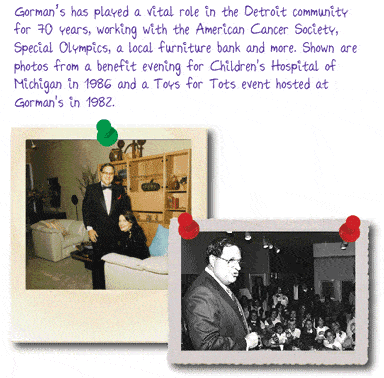
Happily, it was also the fortieth season since the Detroit Tigers had entered the American League in 1901, cause for fans to celebrate! The always innovative Goebel Brewing Company was blazing bold new trails in marketing savvy. And already nearly half (47.2 per cent) of the city’s labour force was gaining its livelihood from the burgeoning automotive industry, and the multiple allied branches of manufacturing. More foreboding, the U.S. government built an arsenal just 17 miles northeast of Detroit to support the allied war effort.
But for perceptive Ben Gorman, the time was right. His entrepreneurial idea, to take damaged freight goods from the many railroads that converged upon metropolitan Detroit and resell to the highly diverse community. At first he salvaged primarily canned goods and then, soon after, furniture in need of repair began to arrive in the freight yards. This he repaired and resold. Post-Depression savvy citizens quickly caught on, and Gorman’s became Michigan’s place to go for home furnishings!
In 1965, he sold the company to Bernie Moray. Now the CEO, Moray still leads Gorman’s with his business partners Tom Lias, Jeff Roberts and John Moray.
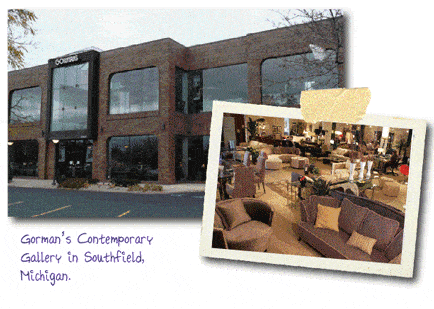
Bernie Moray opened the Contemporary Gallery located in Southfield, Michigan in 1966. Eleven years later, Moray and his partner Jeff Roberts, expanded the company with their traditional furnishings showroom in Troy. There were two more additions, the third location in Novi in 1995, and Gorman’s Lakeside store in the year 2000.
“In the 45 years since I purchased Gorman’s, I am truly amazed at what we have accomplished as a company,” said Bernie Moray. “We make sure that we never forget where we came from and what Ben Gorman did to start this company. We strive to embody his ideals and commitment to quality and customer service every day.”
Recognized as the original Michigan style-leader in home furnishings, they pride themselves on their staff of nearly 50 designers with an amazing combined 1,000 years of residential and office design experience, utilizing Gorman’s unique resource area and textiles library. Their clients range from new homeowners to entertainers, sports celebrities and captains of industry.
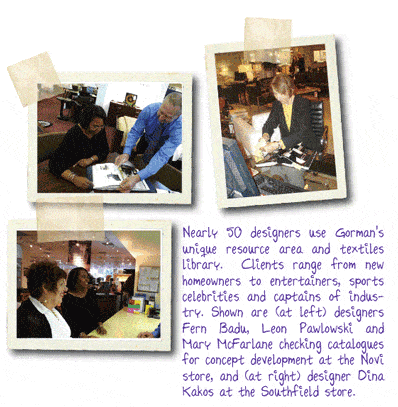
Said Bernie Moray, “Our eureka moment occurred when we made the decision to go from one brand, Drexel Heritage, to featuring 100 brands, a different way of doing business.”
Gorman’s also offers 13 specialty shops, “to ensure customers find exactly what they want”. The shops include Casual Dining, Health, Home Accessories, Furniture as Art, Leather, World Collections, Home Entertainment, Motion and Comfort, Gorman’s Kids, Home Office, Small Office, Sleep, and Window Fashions.
“Gorman’s 100” are some of the industry’s most celebrated brands, Henredon, Natuzzi, Hancock and Moore, Sligh, Lexington, Century, Stanley, Hooker, Bernhardt, still Drexel Heritage and a host of others.

All four stores use Gorman’s “Must Be Right” policy to the max. As outlined on their excellent website (www.gormans.com) “Must Be Right” is regarded as and adhered to as their signature. “Before you arrive, we assure you that Gorman’s is prepared to make presentations that meet your expectations. Whether your interests lie in classical motifs and traditional ambience, or in the latest contemporary trends, our objective is to help you visualize all the choices you have to achieve your unique design goals.
“While you work with us, we assure you that the professional staff members who assist you are experienced, informed and, above all, sensitive to your needs, that you and your specific requirements come first and foremost.
“After your purchase, we assure you that everything meets our standards for quality, specifications and service. If there is a problem, Gorman’s will correct it.
“In short, we assure you that everything must be right, or we will make it right.
“That is more than our promise. It is our policy.”
The website under “News” suggests you “Find Your Inspiration at Gorman’s”, and no less than six well written, informative features are available, Lighten Up, 10 Tips for Using Colours, Tips ‘n Tidbits: The Wing Chair, Awesome Area Rugs, Flat Screen TV’s Now Have a Home and Today’s Dining: Dazzle or Casual? all designed, of course, to help the consumer plan their ultimate décor.
The company has declared its commitment to environmental matters, using several different waste saving techniques, installing energy reducing equipment and analyzing the recycling of foam products.
Gorman’s has played a vital role in the Detroit community for 70 years now, working with the American Cancer Society, Special Olympics, Haven, local children’s hospitals and more. And they fully support the Furniture Bank and Furniture Resource Centre with products to continue their good work.
Decorium
Across the friendliest border in the world, the city of Toronto has long been a destination of choice for entrepreneurs. Fourth generation Steve Forberg told us about his grandfather who, fresh from Poland, made his start in manufacturing home furnishings when he founded Starchrome Furniture, the largest metal furniture company in Canada in the ‘40s, ‘50s and ‘60s.
Steve’s father, Joe, established his own business, Furniture Plaza, in the ‘70s. By the early ‘80s, they had changed the name to Grand Design. Soon Forberg energy generated seven stores, “all over the GTA (Greater Toronto Area), the city of Toronto, Mississauga, Markham, two in North York, and west to London and Kitchener”. The then distribution centre at Supertest Road off Dufferin Street in near-north Toronto is the site of the present day Forberg enterprise, Decorium.

Most of us remember the recession of the late ‘80s and early ‘90s. “Our company had gone through some tough times in the early ‘90s. By this time we had eight Grand Design stores. Once the GST/PST (Goods and Services Tax and Provincial Sales Tax) hit as well as the recession, we closed the eight stores and opened one 5,000 square foot store which today has evolved into a 60,000 square foot showroom that generates more business from one than the eight ever did! This moment and the change in direction was what has made us the success story we are today.
“I came into the business in 1996, just as things started to change. I had spent a couple of years as marketing director for Sports Authority, before pursuing our family business. Since 2007, my father, Joe, brother Howard, and me have run Decorium. Howard’s in charge of sales, amongst other areas of the business. Dad comes into the store three or four days a week when he’s at home and his input is invaluable.”
Steve has a degree in Business Administration as well as a huge imagination and he “does all the buying, all the advertising and oversees the operations end of things.
“The main policy and/or success we have is that we are ‘small enough to care and LARGE enough to bring our clients great value’. We will bend over backwards for our clients and do many things that most traditional stores cannot. We will have made a special sized ottoman or chair for our clients if they need them. We will do whatever it takes to provide our clients with the beautiful home they so desire. As well, we have an ever-changing assortment and, in this fashion business, colours, styles and trends change rapidly. We keep the merchandise fresh and new for both our staff and our clients. We have clients who come here weekly to see what is new and what has changed. Each week we put anywhere from 30 to 100 new items on our floor. This has made our business different, and allowed our clients an opportunity to explore more than just a furniture store, but a home fashion store.”
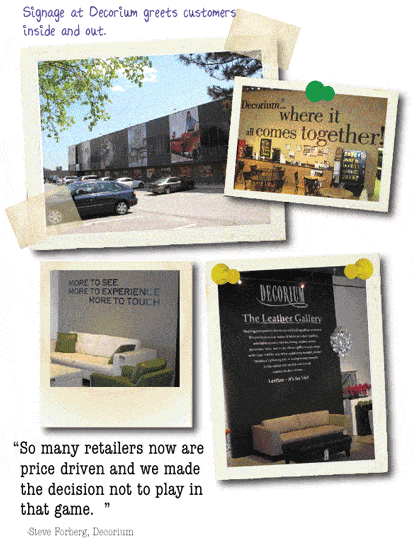
In the last few years, the forward-thinking Forberg’s have structured an innovative corporate division, recognizing and applauding the enormous surge in Toronto’s condominium development. They have created furniture packages for developers, “furnishing units completely down to lamps and accessories, absolutely turn key. If the purchasers are local they receive from the builder a Decorium discount card, excellent exposure for us, of course. Our corporate designer, Debbie Fernandez, devotes herself to this fascinating challenge; she is a super talent.
“And we have our own design centre within the store; this helps to get the consumer engaged in colour coordinating. Our Internet room planner is a great feature, too, both in the store and on the web. Consumers measure their space at home, then spend time on their computers moving furniture about. Then they e-mail the result to our designers to pre-pick possible pieces. Or they bring the plans in with them when they visit.
“Decorium is a destination store and, because of our location, we don’t entertain many browsers. People come to us because we give them what they really want. Today’s consumers are different, and we must all flex to change. They’re a lot more educated and confident, and before they come to us they know, in many cases from our website, from shelter magazines and television design programmes, what they are looking for, the style, the trends and where the product is manufactured, the construction components of the pieces, and they have a pretty good idea of pricing.
They are much farther ahead in the buying process, stage four, not stage one. We have to adapt to each, individual consumer. A degree in psychology would help!
“We collect information from the consumer both from our website and from our kiosk at the front door. They are asked to register with us, to give us their name, e-mail address and so forth, helping us to build our database. Once they’re registered, we offer them a broad spectrum of opportunities, including our very popular $1,000 shopping spree, no purchase necessary, they can enter in the store or online.
“Every month I broadcast an e-mail newsletter which incorporates four day promotional incentives, news about trends, what’s happing in décor, an e-blast! The special incentives are not offered to the public at large. We do a lot online with banner advertising and word scan and Google search words.
“We’re a very service oriented company, both pre and post-sale. If, for instance, a customer decides they really don’t like a fabric, we will work with them, find a fabric they do like and send the piece out to our upholsterer. They made the decision to come to you for their needs; we believe in giving the customer what they really want. Customization.
“Our best customers are those that have had service. We take care of anything, major or minor, large or small. We handle problems after the manufacturers’ warranties have expired. Business is all about relationships and customer service.” (Check out Decorium’s website testimonials, www.decorium.com)
“There are more channels for the consumer to purchase furniture than ever before. The big box stores, the super centres, even grocery stores. Consumers can become confused. We have to be first, we have to be different, our merchandise, our service and our display. So many retailers now are price driven and we made the decision not to play in that game. Instead we operate in the upper middle market with style, value, selection and service.
“We are very active in the community and for several years now we’ve worked with Toronto’s Princess Margaret Hospital. Annually, they run a huge, fund-raising lottery, giving away large Tridel and Greenpark homes and condos. We furnish the model homes for them.”
Sometime ago, the team developed a new section within Decorium they called “Surroundings”, a 10,000 square foot gallery showing “very functional furniture, completely contemporary”. They promoted it with a colourful insert in Canada’s national newspaper, The Globe and Mail. The insert announced a four-day event, “Save up to 50% OFF storewide”, and it was a very successful promotion.
For additional exposure, Steve uses publications such as House and Home, Style at Home, Post City Magazine and Home and Décor, plus Cineplex advertising and radio.
In December, 2010, Decorium launched a new 10,000 square foot Leather Gallery, located on the lower level of its 100,000 square foot store. Said Steve, “We’re very excited to have this new, unique concept within our store. The look and feel of this Gallery provides our clients with just what they are looking for in a leather store. We have been very selective about the price range, and the suppliers we partnered with.” The new line-up includes items from Futura, Bernhardt, Lind, Palliser, Décor-Rest and Sunpan, with a product selection covering every style.
The Gallery has its own dedicated and well-trained leather experts, to help optimize the shopping experience. And, of course, there’s a new website that displays the full range of products; simply click on “Leather Gallery”.
“Knowledge is key,” said Steve, “and we can always learn something from someone else at any age and at any point in life.” In 1999, Steve attended a U.S. based performance and friendship group that opened his consciousness to a well spring of information. The meeting served as his introduction to the concept of open intellectual exchange amongst industry peers. Still an enthusiastic member and the only Canadian retailer in this exclusive furniture sector gathering, Steve asserts, “We all have the same issues, the same likes and dislikes. We share information on everything, advertising, marketing, product lines, even our financials. It’s well worth the investment in time and money.”
Steve is convinced that, “The industry must share information, not necessarily in their own trading area, but in general; we could all learn so much more.”
Art Van
Art Van Elslander is a bit of a legend, especially in those cities where he has established a firm footprint. Art Van Furniture is a family owned company that first saw the light of day in 1959 in Detroit, Michigan, almost a decade after Ben Gorman initiated his entrepreneurial adventure.
The original store was a compact 4,000 square feet. From the beginning, the Van Elslanders’ philosophy has been to provide their “guests” with quality furniture at prices lower than competing discount stores and, at the same time, offer a full range of services that could only be found at specialty or department stores.
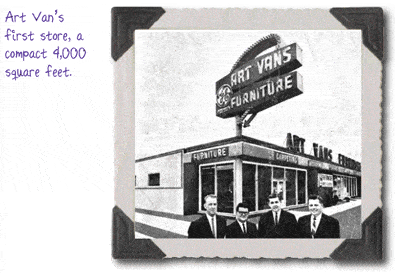
Today, Art Van Furniture operates 34 stores in 33 cities throughout Michigan, and employs approximately 2,500 associates. They have received many accolades from various organizations recognizing their commitment to quality and the community. The National Home Furnishings Association named Art Van Elslander, Founder and Chairman, the 1998 Retailer of the Year, while the Michigan Retailers’ Association named the company 2000 Retailer of the Year. In 2001, Van Elslander was inducted into the American Furniture Hall of Fame, and Detroit News readers have voted Art Van Furniture Michigan’s Best Home Furnishings Store since 2003.Recently, Art Van formed an alliance with Paul’s TV, the “King of Big Screen”, based in California, to open a “store within a store” inside all Art Van locations beginning last March in five Metro Detroit stores. Locations include Warren, Lakeside, Westland, Royal Oak and Taylor, with the remaining 26 stores completed by September of 2010. The alliance has made Art Van Furniture a one-stop shop for complete home entertainment, from recliners and theatre seating to a full selection of the largest and latest TV technology. In keeping with Art Van’s next day delivery, Paul’s TV offers same day or next day delivery, in-home set up and recycle old TVs, a very useful service.
Said Art Van Elslander, “We are responding to the overwhelming demand from our guests who enjoyed our recent furniture and television package promotions. We scoured the country to find the experts in home theatre entertainment who also share our commitment to the customer.”
In response, “We are thrilled to be working with a company that is as committed to serving the customer as we are,” said Babak Ghaznavi, President of Paul’s TV. “All of us are looking forward to many years serving the people of Michigan.”
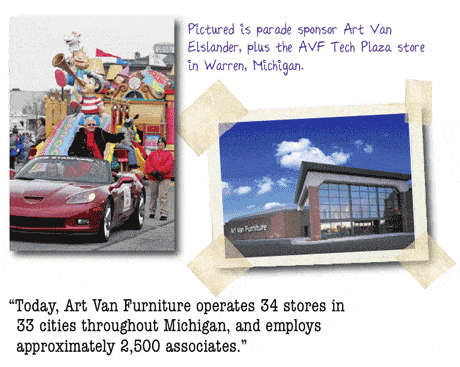
Vital to Michigan’s economy, this new relationship will also create new jobs in the state. Paul’s TV will hire 150 salespeople to staff their stores within all Art Van locations.
In acknowledgment of Art Van’s green efforts, the Michigan Retailers Association named Art Van Furniture a “2007 Green Tailer”. This inaugural honour is given to retailers who are protecting the environment by adopting energy conservation and earth-friendly practices. Here are a few of the steps Art Van is taking to help leave a smaller environmental footprint:
- Installed energy management systems in their stores that decrease yearly utility usage by 15 per cent.
- Recycle 400 tons of cardboard, 35 tons of plastic, 15 tons of steel/metal and three tons of office waste on a monthly basis.
- Built an automated warehouse that created a much smaller footprint than a traditional warehouse and operates using 75 per cent less lighting, heating and cooling.
- Formulated care kits for leather, wood and hard surfaces that are water based, biodegradable, non-hazardous and non-toxic.
- Donates a portion of the proceeds from the sales of their exclusive Grand Shores Collection to the Water Quality Protection Fund of Michigan’s Department of Environmental Quality.
- Partnered with NextEnergy to test B20 (biodiesel) in two of their trucks under different conditions. The results will be used to help set national standards for this alternative fuel, which is made from renewable resources.
- Disposes of used mattresses by using a specially designed shredder that helps reduce the volume of material sent to landfills.
- Donated 7,600 trees in 2007 and 2008 for Arbor Day initiatives.
Now in the company’s fifty-second year, Chairman Van Elslander continues to regard the consumers visiting his outlets as ”guests”, and surely his corporate family’s warm welcome to all who cross Art Van thresholds is key to their enviable growth.
Next Issue
Next month we will continue this series that commemorates the 140th anniversary year of FURNITURE WORLD Magazine.These are your stories, the tales you told us, the dreams that became realities.